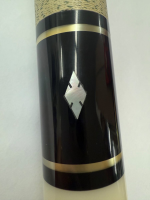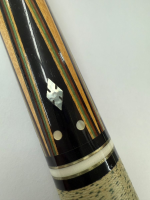You are using an out of date browser. It may not display this or other websites correctly.
You should upgrade or use an alternative browser.
You should upgrade or use an alternative browser.
I am sure you can identify these cues (original Balabushka)
- Thread starter Lépine
- Start date
Bottom right picture.Anyone have a detailed picture of this machining artifact?
Lépine
Active member
Thank you, I have seen that picture but hard to tell what I am looking at either so much dirt in there.
It is a bit hard to see, but there is a groove that is below the portion in which the insert and bolt would go. That's where the residue would built up. I don't think generally dirt, but rather residue from the KU bumper.Thank you, I have seen that picture but hard to tell what I am looking at either so much dirt in there.
Lépine
Active member
The Lisciotti is perfect.
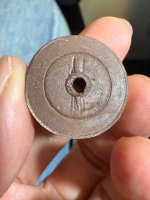

The fancy didn't hold up as well. Looks like the bumper came apart, but someone tried to save it.

The butt caps on both look pretty much the same to me from what I can see of the insides. The fancy has too much going on that I didn't want to go further.
I got it completely off. Bumper has seen some better days.


The fancy didn't hold up as well. Looks like the bumper came apart, but someone tried to save it.
The butt caps on both look pretty much the same to me from what I can see of the insides. The fancy has too much going on that I didn't want to go further.
I got it completely off. Bumper has seen some better days.
Last edited:
I see what you mean about the bumper on the fancy one. Could use a replacement. If you can't find a KU bumper, I believe most cuemakers and cue repairmen have access to new brown bumpers, which are not a bad replacement.
On the fancy one, I do see the groove on the outer edge of the interior surface. This looks like the more typical Balabushka construction. The Lisciotti one does look different, more like a modern cuemaker would do it, with a standard 3/8X16 weight bolt. At least that's what I see. It would be interesting to know if that was a modification later on, or something else. Both great looking cues.
On the fancy one, I do see the groove on the outer edge of the interior surface. This looks like the more typical Balabushka construction. The Lisciotti one does look different, more like a modern cuemaker would do it, with a standard 3/8X16 weight bolt. At least that's what I see. It would be interesting to know if that was a modification later on, or something else. Both great looking cues.
Lépine
Active member
It looks like the same exact toolmarks, it is probably more of a difference in how I photographed it. I didn't think about how am I going to do a side by side photo. Anyway, these are delicate bumpers so I guess better to not keep taking them apart. I understand why there is masking tape on them. I can imagine when brand new, it was harder to install them.I see what you mean about the bumper on the fancy one. Could use a replacement. If you can't find a KU bumper, I believe most cuemakers and cue repairmen have access to new brown bumpers, which are not a bad replacement.
On the fancy one, I do see the groove on the outer edge of the interior surface. This looks like the more typical Balabushka construction. The Lisciotti one does look different, more like a modern cuemaker would do it, with a standard 3/8X16 weight bolt. At least that's what I see. It would be interesting to know if that was a modification later on, or something else. Both great looking cues.
As for the replacement bumper, looks like the closest I can track down is a 1970s Tascarella that looks like the same thing except the color is a different shade. At least by replacing the bumper, I can be assured that no chemical reaction will take place as the bumper is clearly degrading fast.
Lépine
Active member
For historical reference for Larry's cue. Note the FedEx shipping box address shows Pete Tascarella sent the cue to me. The photograph show the paypal $40k payment information to Theresa Tascarella for the purchase from the Tascarella family of Larry Lisciotti's 1965 Burton Spain blank George Balabushka cue.
Attachments
-
 2025-08-14_11-07-30.jpeg94.8 KB · Views: 66
2025-08-14_11-07-30.jpeg94.8 KB · Views: 66 -
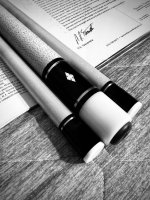 IMG_2405.jpeg472.3 KB · Views: 60
IMG_2405.jpeg472.3 KB · Views: 60 -
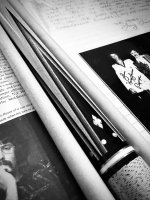 IMG_2406.jpeg327.6 KB · Views: 50
IMG_2406.jpeg327.6 KB · Views: 50 -
 IMG_2407.jpeg342.5 KB · Views: 52
IMG_2407.jpeg342.5 KB · Views: 52 -
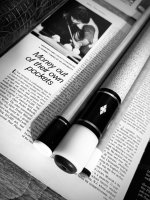 IMG_2408.jpeg362.1 KB · Views: 50
IMG_2408.jpeg362.1 KB · Views: 50 -
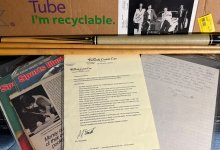 IMG_2514.jpeg370.2 KB · Views: 52
IMG_2514.jpeg370.2 KB · Views: 52 -
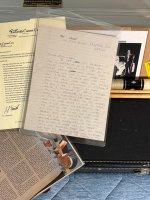 IMG_2515.jpeg419 KB · Views: 55
IMG_2515.jpeg419 KB · Views: 55 -
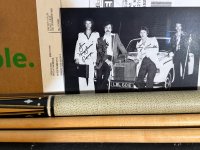 IMG_2516.jpeg375.9 KB · Views: 54
IMG_2516.jpeg375.9 KB · Views: 54 -
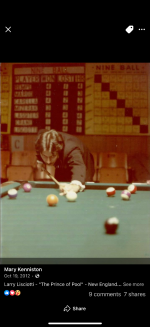 IMG_2626.png642.7 KB · Views: 52
IMG_2626.png642.7 KB · Views: 52 -
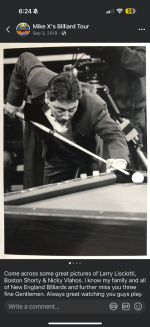 IMG_2627.png590.7 KB · Views: 60
IMG_2627.png590.7 KB · Views: 60
Last edited:
There are NOS originals around.If you can't find a KU bumper, I believe most cuemakers and cue repairmen have access to new brown bumpers, which are not a bad replacement.
I have some.
I traded a full box and a tooled Engles case a few years back for a nice original first catalog Palmer.
Colored bumpers for early McDermott cues are a lot harder to find.
I have spools of #9 too. No, not for sale.
Materials are still around. Some that have them will even deny having them, yes even cue makers.
IMHO such cues should have a KU, not a modern replacement.
Yes, I agree, better to have an original KU bumper for an original Balabushka, if it needs it. I've heard stories of some with some KU bumpers wanting outrageous money for them, but yeah, there are still some out there. Same goes for an early Joss. They used mostly KU bumpers from the beginning until about mid 1976 or so.There are NOS originals around.
I have some.
I traded a full box and a tooled Engles case a few years back for a nice original first catalog Palmer.
Colored bumpers for early McDermott cues are a lot harder to find.
I have spools of #9 too. No, not for sale.
Materials are still around. Some that have them will even deny having them, yes even cue makers.
IMHO such cues should have a KU, not a modern replacement.
With respect to your spools of #9, make sure they're in a nice climate-controlled place. I know of at least one sad sap who went through the horns of hell to get some very rare black spec number 9. When the cuemaker tried to use it, it shredded apart, I would guess dry rot, or not stored correctly.
These both are Superb cues!I am sure those who really know will know just by looking at them.
In ancient Japan, early sword makers did not sign their works. It seems
that idea that those who know would recognize the master who created
the work. To sign a work meant that the sword was not outstanding enough
to identify itself.
View attachment 837680View attachment 837681
I would be very happy owning and playing with the cue on the right...
I Like the layout, and veneers... black, mahogany, Light blue, Natural
thanks for the post!
Lépine
Active member
These both are Superb cues!
I would be very happy owning and playing with the cue on the right...
I Like the layout, and veneers... black, mahogany, Light blue, Natural
thanks for the post!
I am not sure which one is the one you are referring to. Neither one has blue color in it. The Liscotti one is the better cue in my opinion not just because of the history but because the joint is a non-standard size and the wood has changed color to a honey blond color. The feel and playability is slightly better. There is no mistake that the shafts match the butt of the cue due to the special size.
The cue with just 2 MOP dots Below a slotted MOP diamond , in the points...I am not sure which one is the one you are referring to. Neither one has blue color in it. The Liscotti one is the better cue in my opinion not just because of the history but because the joint is a non-standard size and the wood has changed color to a honey blond color. The feel and playability is slightly better. There is no mistake that the shafts match the butt of the cue due to the special size.
To me, the veneers appear, black, mahogany, light blue, white...maybe the 3rd veneer is gray in color....
The cue is awesome ,I like the honey colored wood in the cue shafts too, typically will have a really nice hit and feel with shaft wood like those 2 shafts
Lépine
Active member
It is actually dark green , not light blue. The wood is old growth and likely from more than 100 year old trees. Very dense wood. Amazing it is dead straight on a 1965 shaft and butt. Spinning the cue shows no warping.The cue with just 2 MOP dots Below a slotted MOP diamond , in the points...
To me, the veneers appear, black, mahogany, light blue, white...maybe the 3rd veneer is gray in color....
The cue is awesome ,I like the honey colored wood in the cue shafts too, typically will have a really nice hit and feel with shaft wood like those 2 shafts
Attachments
Lépine
Active member
Someone I know and who has been around long enough in the pool industry told me the other day who is Jon Wright, the person that bought the Balabushka from Larry Lisciotti. He was a cue dealer and notorious for being a gambler that lost a lot. The story goes that if a buyer was interested in one of Wright's cues for sale, the buyers would make a low ball offer and wait. Waiting eventually paid off since Jon would get himself into gambling debt and would need to cover his losses or repay his credit.
In today's market, I don't know about $250K, but you may not be far off. Believe I see fancy Tads, some Ginas, Some Bushkas? Is the box cue the rare Schon box cue?I don't think these have been chalked in decades. (Not mine by the way, belong to a friend) $250k? View attachment 863940
Anyhow gorgeous collection.
Lépine
Active member
I don't remember clearly but I believe it is a Berry Szam in ivoryIn today's market, I don't know about $250K, but you may not be far off. Believe I see fancy Tads, some Ginas, Some Bushkas? Is the box cue the rare Schon box cue?
Anyhow gorgeous collection.
